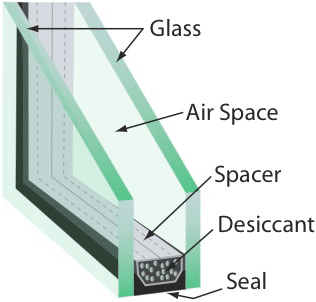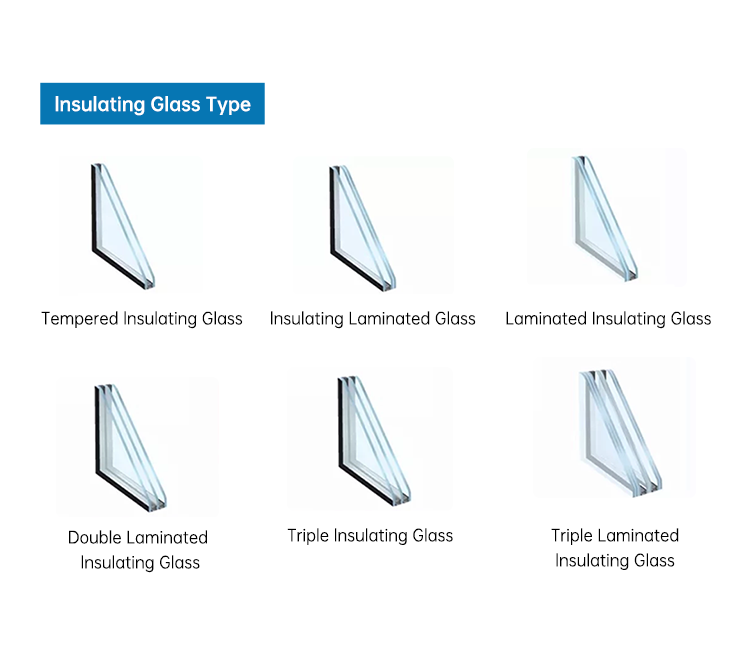
Insulating Glass is comprised of two or more lites of glass connected to each other with a spacer via a primary seal. The spacer is filled with a desiccant and has tiny holes to the inside which allow the desiccant to remove the moisture from the air in the space created. A secondary seal is then applied to provide additional structural integrity and prevent water vapor penetration. 

Low-E Glass
Low-E glass is one of the technological marvels of today’s residential construction. Who would have thought 25 years ago that glass could be coated with an ultra-thin layer of metal? Who would have guessed that this metal coating would allow you to see through the glass and provide actual insulating value?
Features:
- Improves the window U- value (provides a higher R- value) as compared to uncoated glass.
- Allows the inner pane to stay warmer in winter, minimizing condensation and frosting
- Maintains a natural appearance, viewed from the outside or inside.
Benefits:
- Homeowners save on energy costs, for both heating and cooling.
- Homeowners can be assured that the glass in their windows is backed by the strength and experience of a leader in the glass industry.
Low-E glass is one of the technological marvels of today’s residential construction. Who would have thought 25 years ago that glass could be coated with an ultra-thin layer of metal? Who would have guessed that this metal coating would allow you to see through the glass and provide actual insulating value? Not me, that’s for sure! Read on for more information.

E Is For Emissivity
The Webster’s Seventh New Collegiate Dictionary defines emissivity as “the relative power of a surface to emit heat by radiation.” Emit means to “throw or give off.” OK, so Low-E glass obviously is a special glass that has a low rate of emission. In other words, if there is a heat source inside your house (or outside!) the glass bounces the heat from that object back away from the glass. So, in the winter months, if you have Low-E glass in your home, much of the warmth (heat) given off by the furnace and all the objects which the furnace has heated, is bounced back into the room. In the summer, the same thing happens but in reverse. The sun heats up the outside surface of the glass. This heat radiates from the outside and takes the path of least resistance, that being through glass. With Low-E glass much of this heat bounces off the glass and stays outside, rather than being transferred into the home.
Two Types Of Low-E
There are two types of Low-E glass: hard coat and soft coat. As you might imagine they have different properties. In fact, they actually look different.
HARD COAT
Hard coat Low-E glass is manufactured by pouring a thin layer of molten tin onto a sheet of glass while the glass is still slightly soft. The tin actually becomes part of the surface of the glass during the annealing process (slow, controlled cooling.) This process makes it difficult or “hard” to scratch or remove the tin.
SOFT COAT
Soft coat Low-E glass, on the other hand, involves the application of silver, zinc or tin to glass in a vacuum. The glass enters a vacuum chamber filled with an inert gas which is electrically charged. The electricity combined with the vacuum allows molecules of metal to sputter onto the glass. The coating is fairly delicate or “soft.” Furthermore, if silver is used (and it often is) this coating can oxidize if exposed to normal air or being touched with bare skin. For this reason, soft coat Low-E glass must be edge deleted (coating is ground off any area that will be exposed) and used in an insulated glass assembly. Sealing the soft coating in between two pieces of glass protects the soft coating from outside air and sources of abrasion. Also, the space between the two pieces of glass is often filled with argon gas. The argon gas inhibits oxidation of the metallic coating. It also acts as an additional insulator. The two types of Low-E glass have different performance characteristics. The soft coat process has the ability to reflect more heat back to the source. It typically has a higher R value. R values are a measure of resistance to heat loss. The higher the R value of a material, the better its insulating qualities.

ARGON
Argon is a colorless, odorless, non-flammable, non-reactive, inert gas. Argon gas fills are used to reduce heat loss in sealed units by slowing down convection inside the air space. Argon gas is extremely cost-efficient, and works well with Low-e coated glazing. When we talk about insulating glass without a low-e coating, we refer to glass that uses air between panes as a primary source of insulation. As air itself is a good insulator, filling the gap between the glass panes with a low conductivity gas such as argon improves window performance by reducing conductive and convective heat transfers. This phenomenon results from the fact that the density of the gas is greater than the density of the air. Argon is the most commonly used fill gas, due to its excellent thermal performance and cost-efficiency in comparison to other gas fills. Another factor that influences the thermal performance of the IG window is the width of the air space between the panes of glass. Tests have shown that the optimum efficiency for argon is in 12mm and 14mm IG units.